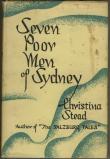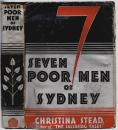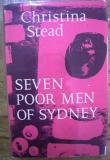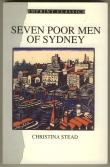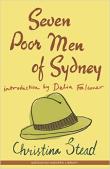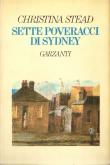AustLit
Latest Issues
AbstractHistoryArchive Description
'Seven Poor Men of Sydney is a brilliant portrayal of a group of men and women living in Sydney in the 1920s amid conditions of poverty and social turmoil.
Set against the vividly drawn backgrounds of Fisherman's (Watson's) Bay and the innercity slums, the various characters seek to resolve their individual spiritual dilemmas; through politics, religion and philosophy.
Their struggles, their pain and their frustrations are portrayed with consummate skill in this memorable evocation of a city and an era.' (Publication summary)
Contents
- Introduction, single work criticism
Publication Details of Only Known VersionEarliest 2 Known Versions of
Other Formats
- Also sound recording; large print.
Works about this Work
-
Dazzling Book by a Sydney Girl
single work
review
— Review of Seven Poor Men of Sydney 1934 single work novel -
Do Australian Modernisms Strike Back? Still Harping on ‘Margins’
2024
single work
criticism
— Appears in: Rethinking Peripheral Modernisms 2024; (p. 99-118)'New modernist studies problematise the term ‘modernism’, its uses and abuses, therefore views on non-hierarchical modernist constellations exemplify the “simultaneous uncontemporaneities” Patrick Williams expanded upon in 2000. The purported ‘belatedness’ of ‘other’ modernisms is predicated on such premises, with Oceania, and more specifically Australia, as a fertile case in question. By looking askance at peripheral modernisms, and thus trying to read against the grain of a stale and debatable centre/margin cultural divide, this paper investigates many received assumptions by focussing on two women writers who have both been marginally included under the ‘modernist umbrella’: Christina Stead, an Australian expatriate to both Britain and the US, and Eleanor Dark, who chose to remain unabashedly local. In particular, I investigate Waterway (1938) and Seven Poor Men of Sydney (1934), novels in which Dark and Stead portray the metropolitan fluidities of the capital city of a settler-state described by John Williams as a “quarantined culture”.' (Publication abstract)
-
y
 Sydney and Its Waterway in Australian Literary Modernism
New York (City)
:
Palgrave Macmillan
,
2021
21207298
2021
multi chapter work
criticism
Sydney and Its Waterway in Australian Literary Modernism
New York (City)
:
Palgrave Macmillan
,
2021
21207298
2021
multi chapter work
criticism
'This book examines literary representations of Sydney and its waterway in the context of Australian modernism and modernity in the interwar period. Then as now, Sydney Harbour is both an ecological wonder and ladened with economic, cultural, historical and aesthetic significance for the city by its shores. In Australia’s earliest canon of urban fiction, writers including Christina Stead, Dymphna Cusack, Eleanor Dark, Kylie Tennant and M. Barnard Eldershaw explore the myth and the reality of the city ‘built on water’. Mapping Sydney via its watery and littoral places, these writers trace impacts of empire, commercial capitalism, global trade and technology on the city, while drawing on estuarine logics of flow and blockage, circulation and sedimentation to innovate modes of writing temporally, geographically and aesthetically specific to Sydney’s provincial modernity. Contributing to the growing field of oceanic or aqueous studies, Sydney and its Waterway and Australian Modernism shows the capacity of water and human-water relations to make both generative and disruptive contributions to urban topography and narrative topology.'
Source : publisher's blurb
-
Modernity in the Antipodes : Politics and Aesthetics in Christina Stead’s Seven Poor Men of Sydney
2020
single work
criticism
— Appears in: Antipodes , vol. 34 no. 2 2020; (p. 180-199) 'Having grown up in Sydney in the first decades of the twentieth century, Christina Stead left Australia in 1928 at the age of twenty-six and returned only forty years later. Critical responses to Stead’s work tended to repress her Australianness, even when those critical responses came from Australians themselves; in 1948, Nettie Palmer commented on walking past an “impressive shopfront showing American and English classics and moderns in good editions: Shakespeare, Hemingway, Gertrude Stein, Whitman, Quixote (English), Christina Stead, Thackeray” (Palmer 149). Stead’s first novel, Seven Poor Men of Sydney (1934), is the least ambiguously Australian of all her works, centered on a group of workers at a printing press in Sydney in the 1920s. This novel is important in the history of Australian literary fiction, arriving early in the development of an ossified split between modernist and realist modes—a split that was to become a defining schism of Australian literature in the subsequent decades. The social, political, and cultural tensions that fed the perceived split between modernist and realist writing in Australia—tensions that revolved around the role of organized left-wing politics in social life and the relationship of Australia to modernity and empire—receive a deep and extended treatment in Stead’s novel. These tensions play out at a formal level in the coexistence of both realist and modernist strategies of representation in Stead’s novel, strategies deeply influenced by Stead’s reading of both nineteenth-century French realist fiction and the modernist avant-garde. The challenge when reading Seven Poor Men of Sydney is to be sensitive to both the European literary and intellectual tradition that undoubtedly nourished her work and the Australian context out of which it was born.' -
In Triumph Over the Spirit Lost : Revisiting Seven Poor Men of Sydney
2020
single work
essay
— Appears in: Overland [Online] , June 2020;
-
A Reader's Notebook
1935
single work
review
— Appears in: All About Books , 11 February vol. 7 no. 2 1935; (p. 21-23)
— Review of Hard Light 1932 single work poetry ; Melbourne Odes 1934 selected work poetry prose ; Love Redeemed 1934 selected work poetry ; Seven Poor Men of Sydney 1934 single work novel ; An Eden of the Good 1934 single work novel -
Australian Literature Society [Meeting Report]
1935
single work
review
column
— Appears in: All About Books , 12 July vol. 7 no. 7 1935; (p. 119)
— Review of Saraband for Dead Lovers 1935 single work novel ; Seven Poor Men of Sydney 1934 single work novel ; Forty-Six : 46 1934 single work novel ; Lest We Lose Our Edens 1935 single work novel -
[Review] Miss Herbert (The Suburban Wife)
1935
single work
review
— Appears in: The North Queensland Register , 26 January 1935; (p. 25)
— Review of Seven Poor Men of Sydney 1934 single work novel -
Young Xavier is No Idealist
1991
single work
review
— Appears in: The Weekend Australian , 26-27 January 1991; (p. rev 6)
— Review of South of Capricornia : Short Stories 1925-1934 1990 selected work short story ; Seven Poor Men of Sydney 1934 single work novel ; Capricornia : A Novel 1938 single work novel -
Paperbacks
1991
single work
review
— Appears in: The Sunday Herald (Sunday Review) , 27 January 1991; (p. 17)
— Review of Blessed City : The Letters of Gwen Harwood to Thomas Riddell, January to September 1943 1990 selected work correspondence ; Painted Woman 1989 single work novel ; Seven Poor Men of Sydney 1934 single work novel -
A Note on Christina Stead and China
2003
single work
criticism
— Appears in: JASAL , vol. 2 no. 2003; (p. 93-97) Discusses the representations of China and Chinese people in Christina Stead's work. -
Christina Stead in Japanese
2003
single work
criticism
— Appears in: JASAL , vol. 2 no. 2003; (p. 99-103) Examines some Stead correspondence relating to a proposed translation of Seven Poor Men of Sydney into Japanese that did not eventuate 'due to the financial difficulties and eventual collapse of the intended publisher' (p.99). -
'Those Boys Told Me Everything' : The Politics of the Secretary of Christina Stead's 1930s Fiction
2003
single work
criticism
— Appears in: Antipodes , June vol. 17 no. 1 2003; (p. 29-35)Rooney examines how 'Stead's fiction intricately negotiates her encounters with these [the banking and Popular Front politics worlds] divergent "phallocracies" through the multivalent and liminal figure of the secretary.' Rooney notes that while 'Stead's narrative use of the male political secretary safeguards her identity as a socially accepatable women' it also provides 'a context for discerning the nature of her contribution to 1930s debates about capitalism, communism and revolution.'
-
Best Sellers and A.B.A. Recommendations
1935
single work
column
— Appears in: All About Books , 11 February vol. 7 no. 2 1935; (p. 26-27) -
Christina Stead's "Seven Poor Men of Sydney"
1993
single work
criticism
— Appears in: The Radical Tradition : Lawson, Furphy, Stead 1993; (p. 59-82) Studies in Classic Australian Fiction 1997; (p. 160-186) 'When Christina Stead's Seven Poor Men of Sydney appeared in 1934 the dominant themes of Australian writing were rural, the characteristic settings were the country, the bush and the outback. There had, of course, been poems and fiction written about the cities; it isn't the case that there were no urban materials. Henry Lawson had written powerfully about urban poverty in the series of stories set in 'Jones' Alley' in the 1890s and had begun his career with the powerful urban ballads 'Faces in the Street' and 'The Army of the Rear'. William Lane's The Workingman s Paradise (1892) had described urban conditions in Sydney in the 1890s. But the received impression is of a literature devoted to perpetuating the outback myth of Australia, even though the population was predominantly urban.216 Seven Poor Men of Sydney can be seen as a work confronting and challenging this outback myth.' (Introduction)

